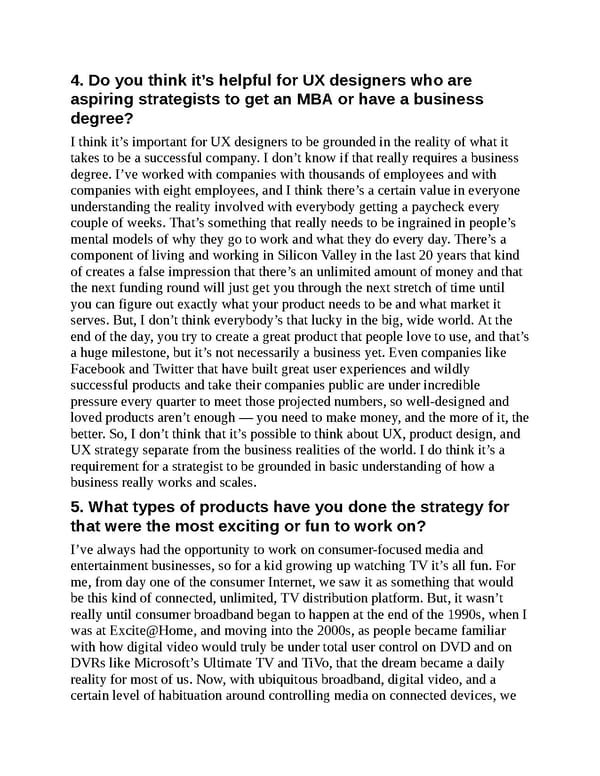4. Do you think it’s helpful for UX designers who are aspiring strategists to get an MBA or have a business degree? I think it’s important for UX designers to be grounded in the reality of what it takes to be a successful company. I don’t know if that really requires a business degree. I’ve worked with companies with thousands of employees and with companies with eight employees, and I think there’s a certain value in everyone understanding the reality involved with everybody getting a paycheck every couple of weeks. That’s something that really needs to be ingrained in people’s mental models of why they go to work and what they do every day. There’s a component of living and working in Silicon Valley in the last 20 years that kind of creates a false impression that there’s an unlimited amount of money and that the next funding round will just get you through the next stretch of time until you can figure out exactly what your product needs to be and what market it serves. But, I don’t think everybody’s that lucky in the big, wide world. At the end of the day, you try to create a great product that people love to use, and that’s a huge milestone, but it’s not necessarily a business yet. Even companies like Facebook and Twitter that have built great user experiences and wildly successful products and take their companies public are under incredible pressure every quarter to meet those projected numbers, so well-designed and loved products aren’t enough — you need to make money, and the more of it, the better. So, I don’t think that it’s possible to think about UX, product design, and UX strategy separate from the business realities of the world. I do think it’s a requirement for a strategist to be grounded in basic understanding of how a business really works and scales. 5. What types of products have you done the strategy for that were the most exciting or fun to work on? I’ve always had the opportunity to work on consumer-focused media and entertainment businesses, so for a kid growing up watching TV it’s all fun. For me, from day one of the consumer Internet, we saw it as something that would be this kind of connected, unlimited, TV distribution platform. But, it wasn’t really until consumer broadband began to happen at the end of the 1990s, when I was at Excite@Home, and moving into the 2000s, as people became familiar with how digital video would truly be under total user control on DVD and on DVRs like Microsoft’s Ultimate TV and TiVo, that the dream became a daily reality for most of us. Now, with ubiquitous broadband, digital video, and a certain level of habituation around controlling media on connected devices, we
 UX Strategy: How to Devise Innovative Digital Products that People Want Page 315 Page 317
UX Strategy: How to Devise Innovative Digital Products that People Want Page 315 Page 317